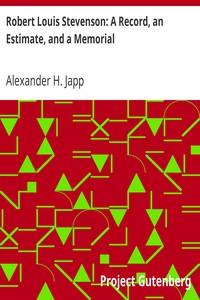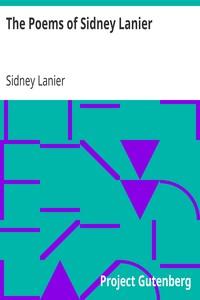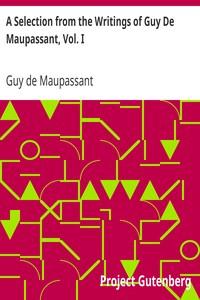Read this ebook for free! No credit card needed, absolutely nothing to pay.
Words: 9402 in 3 pages
This is an ebook sharing website. You can read the uploaded ebooks for free here. No credit cards needed, nothing to pay. If you want to own a digital copy of the ebook, or want to read offline with your favorite ebook-reader, then you can choose to buy and download the ebook.


: Robert Louis Stevenson: A Record an Estimate and a Memorial by Japp Alexander H Alexander Hay - Stevenson Robert Louis 1850-1894; Authors Scottish 19th century Biography Biographies
Of the portraits of Stevenson a word or two may be said. There is a very good early photograph of him, taken not very long before the date of my visit to him at Braemar in 1881, and is an admirable likeness--characteristic not only in expression, but in pose and attitude, for it fixes him in a favourite position of his; and is, at the same time, very easy and natural. The velvet jacket, as I have remarked, was then his habitual wear, and the thin fingers holding the constant cigarette an inseparable associate and accompaniment.
He acknowledged himself that he was a difficult subject to paint--not at all a good sitter--impatient and apt to rebel at posing and time spent in arrangement of details--a fact he has himself, as we shall see, set on record in his funny verses to Count Nerli, who painted as successful a portrait as any. The little miniature, full-length, by Mr J. S. Sarjent, A.R.A., which was painted at Bournemouth in 1885, is confessedly a mere sketch and much of a caricature: it is in America. Sir W. B. Richmond has an unfinished portrait, painted in 1885 or 1886--it has never passed out of the hands of the artist,--a photogravure from it is our frontispiece.
There is a medallion done by St Gauden's, representing Stevenson in bed propped up by pillows. It is thought to be a pretty good likeness, and it is now in Mr Sidney Colvin's possession. Others, drawings, etc., are not of much account.
And now we come to the Nerli portrait, of which so much has been written. Stevenson himself regarded it as the best portrait of him ever painted, and certainly it also is characteristic and effective, and though not what may be called a pleasant likeness, is probably a good representation of him in the later years of his life. Count Nerli actually undertook a voyage to Samoa in 1892, mainly with the idea of painting this portrait. He and Stevenson became great friends, as Stevenson naively tells in the verses we have already referred to, but even this did not quite overcome Stevenson's restlessness. He avenged himself by composing these verses as he sat:
Did ever mortal man hear tell o' sic a ticklin' ferlie As the comin' on to Apia here o' the painter Mr Nerli? He cam'; and, O, for o' human freen's o' a' he was the pearlie-- The pearl o' a' the painter folk was surely Mr Nerli. He took a thraw to paint mysel'; he painted late and early; O wow! the many a yawn I've yawned i' the beard o' Mr Nerli. Whiles I wad sleep and whiles wad wake, an' whiles was mair than surly; I wondered sair as I sat there fornent the eyes o' Nerli. O will he paint me the way I want, as bonnie as a girlie? O will he paint me an ugly tyke?--and be d-d to Mr Nerli. But still an' on whichever it be, he is a canty kerlie, The Lord protect the back an' neck o' honest Mr Nerli.
Mr Hammerton gives this account of the Nerli portrait:
"The history of the Nerli portrait is peculiar. After being exhibited for some time in New Zealand it was bought, in the course of this year, by a lady who was travelling there, for a hundred guineas. She then offered it for that sum to the Scottish National Portrait Gallery; but the Trustees of the Board of Manufactures--that oddly named body to which is entrusted the fostering care of Art in Scotland, and, in consequence, the superintendence of the National Portrait Gallery--did not see their way to accept the offer. Some surprise has been expressed at the action of the Trustees in thus declining to avail themselves of the opportunity of obtaining the portrait of one of the most distinguished Scotsmen of recent times. It can hardly have been for want of money, for though the funds at their disposal for the purchase of ordinary works of art are but limited, no longer ago than last year they were the recipients of a very handsome legacy from the late Mr J. M. Gray, the accomplished and much lamented Curator of the Scottish National Portrait Gallery--a legacy left them for the express purpose of acquiring portraits of distinguished Scotsmen, and the income of which was amply sufficient to have enabled them to purchase this portrait. One is therefore almost shut up to the conclusion that the Trustees were influenced in their decision by one of the two following reasons:
"1. That they did not consider Stevenson worthy of a place in the gallery. This is a position so incomprehensible and so utterly opposed to public sentiment that one can hardly credit it having been the cause of this refusal. Whatever may be the place which Stevenson may ultimately take as an author, and however opinions may differ as to the merits of his work, no one can deny that he was one of the most popular writers of his day, and that as a mere master of style, if for nothing else, his works will be read so long as there are students of English Literature. Surely the portrait of one for whom such a claim may legitimately be made cannot be considered altogether unworthy of a place in the National Collection, as one of Scotland's most distinguished sons.
"2. The only other reason which can be suggested as having weighed with the Trustees in their decision is one which in some cases might be held to be worthy of consideration. It is conceivable that in the case of some men the Trustees might be of opinion that there was plenty of time to consider the matter, and that in the meantime there was always the chance of some generous donor presenting them with a portrait. But, as has been shown above, the portraits of Stevenson are practically confined to two: one of these is in America, and there is not the least chance of its ever coming here; and the other they have refused. And, as it is understood that the Trustees have a rule that they do not accept any portrait which has not been painted from the life, they preclude themselves from acquiring a copy of any existing picture or even a portrait done from memory.
"It is rumoured that the Nerli portrait may ultimately find a resting- place in the National Collection of Portraits in London. If this should prove to be the case, what a commentary on the old saying: 'A prophet is not without honour save in his own country.'"
Mr Baildon's words are:
Which just shows how far lapse as to a fact may lead to critical misreadings also.
Free books android app tbrJar TBR JAR Read Free books online gutenberg
More posts by @FreeBooks



: The Chinese Nightingale and Other Poems by Lindsay Vachel - World War 1914-1918 Poetry; American poetry; Fairy tales Poetry






